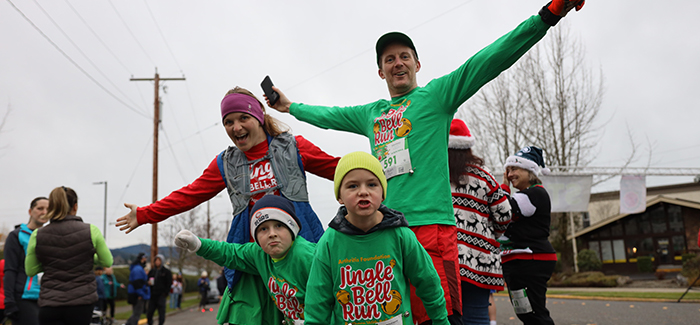5 Walking Strategies
Use these strategies for a successful arthritis walking program whether you’re just starting or trying to stick to a routine.
By Mary Anne Dunkin
For people of any age with arthritis, walking is especially good medicine. It strengthens muscles, which helps shift pressure from joints and reduce pain. And a regular walking routine compresses and releases the cartilage in your knees, helping circulate synovial fluid that brings oxygen and nourishes your joints. When joints don't get this nourishment, they deteriorate faster.
But despite these benefits, it's not easy to keep walking, day in and day out. To improve your chances of success, try these five walking strategies.
For people of any age with arthritis, walking is especially good medicine. It strengthens muscles, which helps shift pressure from joints and reduce pain. And a regular walking routine compresses and releases the cartilage in your knees, helping circulate synovial fluid that brings oxygen and nourishes your joints. When joints don't get this nourishment, they deteriorate faster.
But despite these benefits, it's not easy to keep walking, day in and day out. To improve your chances of success, try these five walking strategies.
5 Walking Strategies
1. Find a Buddy
One of the best ways to start and maintain a regular walking program is to find a friend committed to walking with you. For Shelly Bay, of Los Angeles, it’s her husband, Greg. “Depending upon my health and the weather, we typically walk about three nights a week,” says Shelly, who has psoriatic arthritis.
But your walking companion doesn’t have to be someone your own age – or even human, says Diane Whaley, PhD, professor of sport and exercise psychology at the University of Virginia in Charlottesville, whose favorite walking partner is her dog. “I walk my dog every day – it not only makes the walk more pleasant, but it keeps me walking when I might not otherwise.”
Walking with a friend, human or canine, is beneficial for a number of reasons, says Whaley. “It makes you feel more safe and secure. It also makes you accountable to another. You know that if you don’t go, you’re letting someone else down.”
Buddy Walking Tips:
But your walking companion doesn’t have to be someone your own age – or even human, says Diane Whaley, PhD, professor of sport and exercise psychology at the University of Virginia in Charlottesville, whose favorite walking partner is her dog. “I walk my dog every day – it not only makes the walk more pleasant, but it keeps me walking when I might not otherwise.”
Walking with a friend, human or canine, is beneficial for a number of reasons, says Whaley. “It makes you feel more safe and secure. It also makes you accountable to another. You know that if you don’t go, you’re letting someone else down.”
Buddy Walking Tips:
- Don’t have a dog? Ask to borrow your neighbor’s friendly pooch. Fido will be thrilled to get an extra walk every day.
- Join a walking club. Call your local YMCA or fitness center, or search the American Volkssport Association site.
- Call an old friend. Been meaning to catch up, but haven’t had time? Renew your acquaintance on foot.
- Make it a date. Share some quality time with your spouse on “date walks.”
2. Do Something Different
If you stride the same block every day, your routine can get old fast. To make walking more pleasurable, find ways to make it different and interesting.
A key to walking fitness is to vary your route, a technique that works well for Bay and her husband. “One of our routes is purely residential; another is residential until we reach the local elementary school, where we loop around the school a few times,” she says. “And when a new high-rise is being built nearby, we walk to it to see how things are coming along.”
Even the same route can be interesting with a little attention and creativity. Count the cats or squirrels in your neighbors’ yards. Be aware of the clouds in the sky, the movement of the trees in the breeze, the feeling of the sun on your skin. “If you pay attention to your surroundings, your walk will go faster,” says Whaley.
Variation Walking Tips:
A key to walking fitness is to vary your route, a technique that works well for Bay and her husband. “One of our routes is purely residential; another is residential until we reach the local elementary school, where we loop around the school a few times,” she says. “And when a new high-rise is being built nearby, we walk to it to see how things are coming along.”
Even the same route can be interesting with a little attention and creativity. Count the cats or squirrels in your neighbors’ yards. Be aware of the clouds in the sky, the movement of the trees in the breeze, the feeling of the sun on your skin. “If you pay attention to your surroundings, your walk will go faster,” says Whaley.
Variation Walking Tips:
- Go the scenic route. Once a week, take a walk in a park, along a lake, at the beach or in the woods.
- Head for the track. If you usually walk in your neighborhood, go to a school and do laps around the track.
- Pretend you’re a tourist, and take a self-guided walking tour of your town.
- Walk wherever you are. Do laps around the playing field during your kids’ baseball games, around the block while waiting for a table at a restaurant or around the mall while waiting for your spouse to finish shopping.
3. Get Good Shoes
A pair of shoes is virtually the only equipment you need for walking, so it’s important to choose the right pair, says Nicholas Abidi, MD, an orthopedic surgeon from Santa Cruz, California. In general, the best shoes – whether dress, casual or athletic – have deep and wide lasts (shoe forms) and are made of cloth or smooth leather, without tight seams that rub the skin.
For walking, he recommends a good-quality running shoe, such as New Balance, Asics GEL or Adidas; or New Balance walking shoes, which come in different widths. You can walk in running shoes, but you shouldn’t run in walking shoes. Beyond that, the right pair will vary somewhat, depending upon your specific problem.
If you have knee osteoarthritis (OA), studies suggest shoes that allow more natural foot motion and flexibility may be best. They reduce knee loading – the load or stress placed on the knee when walking – which plays an important role in the progression of knee OA. “Flat, flexible shoes provide the greatest degree of benefit in terms of knee loading,” says Najia Shakoor, MD, a rheumatologist at Rush Medical College in Chicago. However, she also notes that you have to take into account what your feet may need.
If you need help finding the right shoe, Dr. Abidi recommends visiting a pedorthist – a specialist in using shoes and shoe modifications to solve problems related to the foot and lower limbs. If you find a shoe that works, buy an extra pair, and alternate between them daily.
Shopping Tips:
Shoe Tips:
For walking, he recommends a good-quality running shoe, such as New Balance, Asics GEL or Adidas; or New Balance walking shoes, which come in different widths. You can walk in running shoes, but you shouldn’t run in walking shoes. Beyond that, the right pair will vary somewhat, depending upon your specific problem.
If you have knee osteoarthritis (OA), studies suggest shoes that allow more natural foot motion and flexibility may be best. They reduce knee loading – the load or stress placed on the knee when walking – which plays an important role in the progression of knee OA. “Flat, flexible shoes provide the greatest degree of benefit in terms of knee loading,” says Najia Shakoor, MD, a rheumatologist at Rush Medical College in Chicago. However, she also notes that you have to take into account what your feet may need.
If you need help finding the right shoe, Dr. Abidi recommends visiting a pedorthist – a specialist in using shoes and shoe modifications to solve problems related to the foot and lower limbs. If you find a shoe that works, buy an extra pair, and alternate between them daily.
Shopping Tips:
- Shop later in the day. Your feet swell throughout the day, so it’s best to try on shoes when your feet are larger to ensure a good fit.
- Measure both feet. Don’t assume you wear the same size you wore five years ago; feet get larger as we age.
- Be size wise. If one foot is bigger, buy the size that fits the bigger foot and add an insole, if needed, for the smaller foot.
- Keep it on. Wear the shoe for at least 10 minutes in the store.
- Carry your socks. Wear the same socks to try on shoes that you’ll wear to walk. If you use an orthotic, bring that along, too.
- Shop more often. Replace your shoes every 500 miles (as often as every three to four months if you walk every day).
Shoe Tips:
- Trouble keeping your balance: Try shoes without thick treads, which can stick and cause falls.
- Bunions: Look for roomy shoes without seams that cut across bunions. Women who have trouble finding wide enough shoes may want to try men’s athletic shoes.
- Weak ankles: Try high-top athletic shoes.
- Ankle arthritis or fusion: Look for shoes with rocker bottoms and a little heel lift to take up loss of motion in the ankle.
4. Track Your Progress
It may sound simple, but keeping track of how far, long and often you walk is an important walking strategy because it gives you a real sense of achievement. Experts advise starting with attainable goals – say, walking from your house to the next corner, or walking around the block – and, once you achieve those goals, setting new ones.
Whaley says it’s important to document your achievements by keeping a log or journal. “Don’t just write what you have done, but how you feel about it – even one sentence, so you can start to look for patterns of what’s working and what’s not,” she says. “Then you’ll know how to stay motivated.”
One of the best motivational tools Whaley has found is an inexpensive pedometer that gives you immediate feedback on your efforts. (Just make sure to reset your pedometer each night, and log your steps or miles in your journal.)
Tracking Tips:
Whaley says it’s important to document your achievements by keeping a log or journal. “Don’t just write what you have done, but how you feel about it – even one sentence, so you can start to look for patterns of what’s working and what’s not,” she says. “Then you’ll know how to stay motivated.”
One of the best motivational tools Whaley has found is an inexpensive pedometer that gives you immediate feedback on your efforts. (Just make sure to reset your pedometer each night, and log your steps or miles in your journal.)
Tracking Tips:
- Give yourself an assignment. Start with a one-month goal you know you can reach. Then set another goal for the next month, and keep going.
- Post it and be proud. Keep your walking log where you can see it every day, whether it’s on the wall, in a journal by your bed or on your computer screen.
- Reward yourself. Celebrate your achievement with a new purchase or by going to a movie. (Just don’t reward yourself with food.)
5. Ditch the Excuses
No doubt, there are countless other demands on your time and energy. “I like to call them barriers,” says Whaley. Time, or the lack of it, is the No. 1 barrier to exercise. Yet people who make exercise a priority find the time. “They have no more hours in the day than the rest of us. They just make walking a priority and look for ways to fit it into their day,” she says.
Wilson, for example, treks with friends at lunch and walks frequently on the campus of the VA Medical Center in Bonham, Texas, where she works as a physician assistant. Try making your walk do double duty. Walk to a nearby friend’s house for a visit, or do errands on foot. The Bays sometimes walk to a restaurant, have dinner and then pick up groceries on the way home. “No one says you have to concentrate on walking just as exercise,” says Whaley.
Of course, there will be times when you can’t walk – so accept it. “For many people, walking tends to be an all-or-nothing phenomenon,” says Whaley. “But it’s important sometimes to be able to say, ‘I wasn’t able to do it, but that doesn’t mean I can’t get back out there and start again next week.’” That’s what a habit is all about.
Tips for Overcoming Excuses:
Wilson, for example, treks with friends at lunch and walks frequently on the campus of the VA Medical Center in Bonham, Texas, where she works as a physician assistant. Try making your walk do double duty. Walk to a nearby friend’s house for a visit, or do errands on foot. The Bays sometimes walk to a restaurant, have dinner and then pick up groceries on the way home. “No one says you have to concentrate on walking just as exercise,” says Whaley.
Of course, there will be times when you can’t walk – so accept it. “For many people, walking tends to be an all-or-nothing phenomenon,” says Whaley. “But it’s important sometimes to be able to say, ‘I wasn’t able to do it, but that doesn’t mean I can’t get back out there and start again next week.’” That’s what a habit is all about.
Tips for Overcoming Excuses:
- Schedule it in. Set aside time for your walk, just as you would a business meeting.
- Always be prepared. Keep a pair of walking shoes in your car, and walk whenever you can.
- Have a “Plan B.” If you miss a day, know exactly how you’re going to get back on track.
- Use alternatives. If the weather is bad, walk at the mall or on an indoor track at the gym.
- Listen to your body. On days when your joints ache or you’re really tired, take a shorter walk. But keep moving – a brief walk may end up giving you enough energy for a longer one.
Calling All Jinglers!
It’s Time to Join the Fun at Jingle Bell Run
Be a part of the most festive fun run there is while helping to improve the lives of millions of people living with arthritis. Your participation will help raise awareness and funds for life-changing research and resources.
Register Today

Stay in the Know. Live in the Yes.
Get involved with the arthritis community. Tell us a little about yourself and, based on your interests, you’ll receive emails packed with the latest information and resources to live your best life and connect with others.


